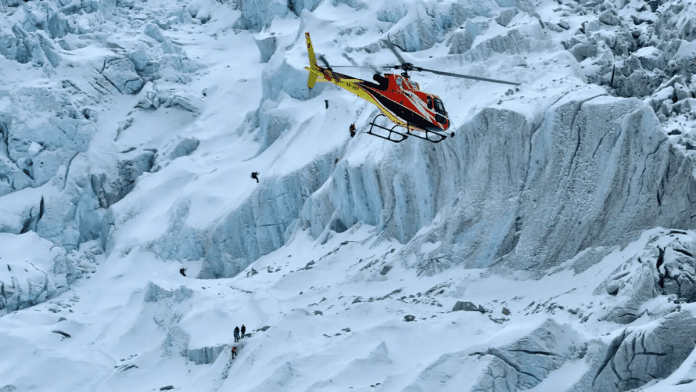🕒 Last updated on October 6, 2025
A sudden snowstorm has trapped nearly 1,000 people on the eastern side of Mount Everest in Tibet. The storm struck a remote valley where hundreds of trekkers were camping, creating dangerous conditions. Rescuers rushed to help those stranded in the harsh weather.
The snowstorm began on Friday evening and continued through Saturday. Trekkers in the Karma Valley, which leads to the eastern Kangshung face of Everest, faced freezing temperatures and heavy snowfall. The valley sits at an altitude of around 4,200 meters (13,779 feet), making rescue efforts even more challenging.
Authorities quickly organized a large-scale rescue operation. Hundreds of local villagers joined rescue teams to clear the snow and guide trekkers to safety. By Sunday, 350 people had safely reached the small township of Qudang. Contact had also been made with over 200 more trekkers, and they were expected to arrive in stages under the guidance of rescuers.
Over 700 wildfires burning across Canada in second-worst season on record
One trekker, Chen Geshuang, described the extreme weather as “wet and cold” with hypothermia a real risk. Chen and his 18-member trekking team managed to reach Qudang, where they were greeted by villagers and offered food and warmth after enduring the harsh conditions.
Trekking Chaos in Tibet
The trapped trekkers were in the remote Karma Valley, a less-traveled side of Everest that is known for its extreme challenges. This area attracts hundreds of tourists, especially during China’s National Day holiday. Many were taking advantage of the holiday to explore the eastern slopes of the mountain.
Local authorities suspended ticket sales and entry to the Everest scenic area starting Saturday to prevent more people from entering the hazardous zones. Rescue teams worked tirelessly, using local knowledge to guide stranded trekkers through snow-blocked paths. Villagers in the region provided food, warmth, and support for those rescued, helping them recover from the freezing conditions.
Communication with the remaining trekkers was established quickly. Teams coordinated their descent in stages to ensure that everyone could safely reach Qudang. The heavy snowfall had blocked roads and trails, making the rescue operation slow but steady. Authorities confirmed that hundreds of people, including Chen Geshuang and his team, were safely brought down and received aid upon arrival.
Super typhoon Ragasa threatens Philippines with flooding and storm surge
Regional Weather Disaster
The snowstorm on Everest coincided with extreme weather in neighboring regions. In Nepal, heavy rain caused landslides and flash floods, destroying roads, bridges, and homes. At least 47 people have died since Friday due to landslides, floods, and lightning strikes.
In the eastern Ilam district of Nepal, landslides claimed 35 lives, while several others were reported missing after being swept away by floodwaters. Lightning strikes in other areas caused additional casualties, showing the widespread impact of the severe weather across the region.
The disaster on Everest highlights the dangers faced by trekkers in high-altitude areas during sudden weather events. Rescue teams and local villagers continue to play a crucial role in ensuring the safety of stranded visitors. Authorities in Tibet and Nepal are coordinating to manage the immediate crisis caused by extreme weather conditions.
The combined efforts of local communities, rescuers, and authorities have successfully brought hundreds of trekkers, including Chen Geshuang’s team, to safety, while work continues to assist the remaining people trapped by the blizzard.

